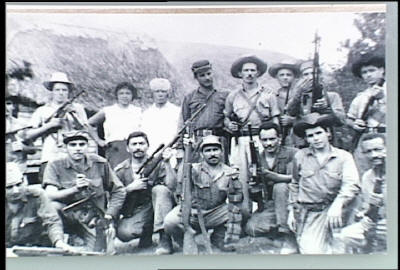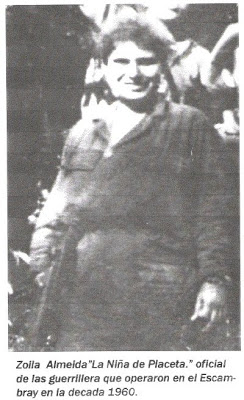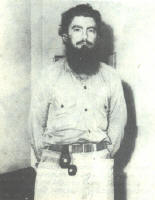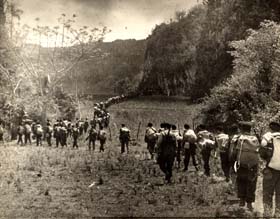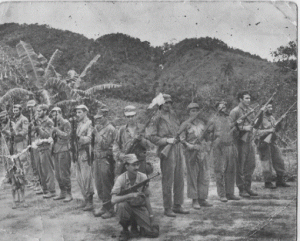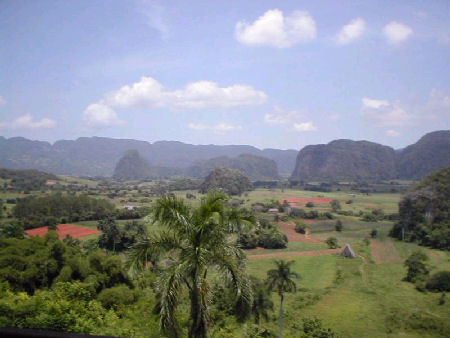IN CUBA, FROM EARLY 1960 TO THE END OF 1966, A FEW THOUSAND FARMERS VERY POOR ARMED FACED IN AN UNEQUAL FIGHT THE MILITARY POWER OF FIDEL CASTRO’S REGIME. WITHOUT PROPER SUPPLIES, HARASSED BY A WELL ARMED ENEMY, THE GUERRILLA WERE EVENTUALLY DEFEATED DESPITE THE FURY AND TOUGHNESS WITH THAT THEY FOUGHT.
MOUNTAINS OF ESCAMBRAY, Cuba: “La Niña de Placetas” STORY.
Since childhood I had heard stories about a young girl who was chief of a group of rebels in Placetas, Las Villas, facing in combat the Castro militias. She had always was considered a legendary figure, but had never even seen a picture of her.
In 1960, in the tufts of the Sierra del Escambray, poorly armed insurgent groups fighting against the Castro regime. In those first months of rebellion, Zoila Aguila went to the Escambray Mountains with her husband, an electrician named Manolo Munsö Remedios La Guardia. The St. Christopher carrying a rifle with six catridges, and she, a revolver with a few bullets.
In the Escambray, where Zoila had fought once before, against Batista, daily grew the legend of the woman guerrilla. Backpack, M1 carbine in hand, La Niña fought the militia under the command of Osvaldo Ramirez, Tommy San Gil, Julio Emilio Carretero. He slept on the slopes of the mountains, went hungry and thirsty, and broke clean shot triple fences Castro militia. In the jungle she bore two daughters, and both died in their arms from hunger and thirst. For 1963, Zoila was head of a guerrilla of twelve men, veteran of hundreds of skirmishes in the mountains villareños.
There is a story that describes well the nerve of the young guerrilla. told by one of the survivors of the heroic deed. Surrounded in a triple fence, Carretero men disbanded, trying to cross the Castro lines undetected. One by one, the Allies were crossing the fence, meet after all at the edge of a stream. Carretero counted heads. Two missing. Manolo and Zoila. Concern increased when they began to hear gunfire in the distance. Carter, who had a good ear for bullets, could discern between shots of machine guns and rifles Czech hammering Manolo Garand and M1 of La Niña. The rebels began running toward the sound of gunfire to rescue the couple. The M1 suddenly silenced. Only listened to the singing of the Garand, the sharp crack of the rifle and the rattle of machine guns. Carretero shouted a curse, thinking that Zoila had fallen in combat and only Manolo was fighting. By attacking the militia in a cross fire and disperse them, the rebels were surprised. Laying in a thicket, with a shoulder injury was Manolo Munsö. Beside him a steaming Garand hands, Zoila Aguila was fighting alone against a squad of militia.
In March 1964, after nearly four years in the Escambray rebels, La Niña and Manolo were captured, betrayed by Alberto Delgado, The Man of Maisinicu, a State Security officer who tricked the guerrillas from Emilio Carretero. Delgado was hanged from a guásima, but before falling betrayed over thirty guerrillas and numerous collaborators, including members of his own family.
In Villa Marist, the State Security offices, Zoila and Manolo were separated. For a while he could speak loudly from cell to cell, but then they changed cell Manolo, that neither corridors shouting could be launched by console. A La Niña was locked in the Black Prince, fourth walled underground, where only the accompanying rats.
Then came the trial. La Niña and eighteen rebels were sentenced to thirty years imprisonment. Twelve fighters were shot. Manolo Munsö La Guardia died in the trenches of the Cabana prison, the evening of June 22, 1964. while singing, with his brothers in the struggle, the national anthem of Cuba.
The girl was taken to the political imprisonment of women. In Guanabacoa, Guanajay, and hypocritically called Finca Nuevo Amanecer, Zoila continued the fight even behind bars. Dam planted, refused to bow. Armed guards with hose pipes beaten. It was boarded up in dark rooms with no light and food. Burned mattresses and was sent to solitary confinement.
They broke her mind, but not his spirit. The madness seized Zoila, but she still insane, refused to rehabilitate. It was much suffering. Two daughters dead. Manolo shot. Manolo and Carretero buried next to a mass grave. Months in punishment cells. Torture. Beatings. Hunger. The made her crazy but could not break her.
In the women’s prison, sitting on her bed, she spent hours wrapped in rags, dressed like a leper, without speaking. When she was allowed to go outside, she climbed into the bushes, where she spent a long time, staring into a distant horizon.
After serving more than half of her sentence, she came to Miami, was one of the last prisoners to leave Cuba.
..Without question, 1960 guerrilla process to 1966, cost the lives of at least three thousand Cubans on both sides of the war, caused the imprisonment of thousands of others, and affected the lives of an entire nation.
Sources:Escambray:LaGuerraOlvidada/EnriqueEncinosa/Excerpt/
InternetPhotos/www.thecubanhistory.com
ESCAMBRAY MOUNTAINS, CUBA: “La Niña de Placetas” Story.
The Cuban History, Arnoldo Varona, Editor
EN CUBA, DESDE PRINCIPIOS DE 1960, HASTA FINALES DE 1966, UNOS CUANTOS MILES DE CAMPESINOS HUMILDES Y MAL ARMADOS SE ENFRENTARON, EN LUCHA DESIGUAL, AL PODERIO MILITAR DEL REGIMEN DE FIDEL CASTRO. SIN SUMINISTROS ADECUADOS, ACOSADOS POR BIEN ARMADAS HUESTES ENEMIGAS, LOS GUERRILLEROS FUERON EVENTUALMENTE DERRROTADOS PESE A LA FURIA Y TENACIDAD CON QUE COMBATIERON.
Sierra del Escambray, Cuba: “La Niña de Placetas”
Desde niño había escuchado cuentos sobre una joven muchacha de Placetas que fue jefa de un grupo de alzados en Las Villas, enfrentándose en combate a las milicias castristas. Siempre la había considerado una figura legendaria, pero nunca había visto siquiera una foto de ella. Ahora, por fin, la iba a conocer y la imagen nebulosa se podría convertir en un ser humano, de carne y hueso.
En 1960, en los penachos de la Sierra del Escambray, grupos de insurgentes mal armados combatían contra el sistema castrista. En esos primeros meses de rebelión, Zoila Aguila se marchó a la manigua con su esposo, un electricista de Remedios llamado Manolo Munso La Guardia. El llevaba una carabina San Cristóbal con seis peines, y ella, un revólver con unas cuantas balas.
En el Escambray, donde Zoila ya había combatido una vez antes, contra Batista, creció día a día la leyenda de la mujer guerrillera. Mochila al hombro, carabina M1 en mano, La Niña combatió a la milicia bajo las órdenes de Osvaldo Ramírez, Tomasito San Gil, y Julio Emilio Carretero. Durmió en las laderas de los montes, pasó hambre y sed, y a tiro limpio rompió los triple cercos de las milicias castristas. En la manigua parió dos hijas, y ambas murieron en sus brazos de hambre y sed. Para 1963, Zoila era jefa de una guerrilla de doce hombres, veterana de centenares de escaramuzas en los montes villareños.
Hay una anécdota que bien describe la sangre fría de la joven guerrillera. contada por uno de los sobrevivientes de la gesta heróica. Rodeados en un triple cerco, los hombres de Carretero se desbandaron, intentando cruzar las líneas castristas sin ser detectados. Uno a uno, los aliados fueron cruzando el cerco, reuniéndose después todos a la orilla de un riachuelo. Carretero contó cabezas. Faltaban dos. Manolo y Zoila. La preocupación aumentó cuando se empezaron a escuchar disparos en la distancia. Carretero, que tenía buen oído para las balas, pudo discernir, entre los disparos de metralletas y rifles checos, el martilleo del Garand de Manolo y el M1 de La Niña. Los alzados comenzaron a correr hacia el sonido de los disparos para socorrer a la pareja. El M1 enmudeció de súbito. Solo se escuchaba el cantar del Garand, el chasquido seco del rifle y el tableteo de las metralletas. Carretero gritó una maldición, pensando que Zoila había caído en el combate y solo Manolo quedaba combatiendo. Al atacar a la milicia en un cruce de fuego y dispersarlos, los alzados quedaron sorprendidos. Acostado en un matorral, con una herida en el hombro se encontraba Manolo Munso. A su lado, con un Garand humeante en las manos, Zoila Aguila se batía sola contra un pelotón de milicia.
En marzo de 1964, después de casi cuatro años alzados en el Escambray, La Niña y Manolo fueron capturados, traicionados por Alberto Delgado, El Hombre de Maisinicu, un oficial de Seguridad del Estado que tendió una trampa a las guerrillas de Emilio Carretero. Delgado murió ahorcado de una guásima, pero antes de caer traicionó a más de treinta guerrilleros y a numerosos colaboradores, incluyendo miembros de su propia familia.
En Villa Marista, las oficinas de Seguridad del Estado, Zoila y Manolo fueron separados. Por un tiempo se podían hablar a gritos de celda a celda, pero después a Manolo lo cambiaron de celda, para que ni a gritos lanzados por pasillos se pudieran consolar. A La Niña la encerraron en el Príncipe Negro, un cuarto tapiado subterráneo, donde sólo las ratas la acompañaban.
Después vino el juicio. La Niña y dieciocho alzados recibieron condenas de treinta años de encarcelamiento. Doce guerrilleros fueron fusilados. Manolo Munso La Guardia murió en los fosos de la prisión de la Cabaña, el anochecer del 22 de junio de 1964. mientras cantaba, junto a sus hermanos de lucha, el Himno Nacional de Cuba.
La Niña fue llevada al presidio político de las mujeres. En Guanabacoa, Guanajay, y la hipócritamente llamada Finca Nuevo Amanecer, Zoila continuó la lucha aún tras las rejas. Presa plantada, se negó a doblegarse. Guardias armados con tubos de manguera la golpearon. Fue tapiada en cuartos oscuros, sin luz y comida. Quemó colchones y fue enviada a celdas de castigo.
Rompieron su mente, pero no su espíritu. La locura se apoderó de Zoila, pero ella aún demente, se negó a rehabilitarse. Era mucho el sufrimiento. Dos hijas muertas. Manolo fusilado. Carretero enterrado junto a Manolo en una fosa común. Meses en celdas de castigo. Torturas. Golpizas. Hambre. La volvieron loca pero no lograron doblegarla.
En la cárcel de mujeres, sentada en su camastro, se pasaba horas envuelta en trapos, vestida como una leprosa, sin hablar. Cuando se le permitía salir al patio, se encaramaba en las matas, donde se pasaba largo rato, la vista perdida en un horizonte lejano.
Después de cumplir más de la mitad de su condena, llegó a Miami, fue una de las últimas presas en salir de Cuba.
Sin discusión, el proceso guerrillero de 1960 al 1966, costó las vidas de por lo menos tres mil cubanos de ambos lados de la contienda, causó el presidio de miles de otros, y afectó la vida de una nación entera.
Sources:Escambray:LaGuerraOlvidada/EnriqueEncinosa/Excerpt/
InternetPhotos/www.thecubanhistory.com
ESCAMBRAY MOUNTAINS, CUBA: “La Niña de Placetas” Story.
The Cuban History, Arnoldo Varona, Editor



